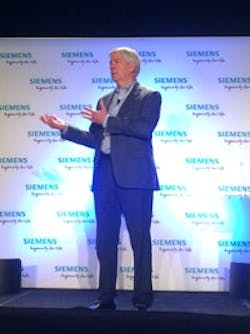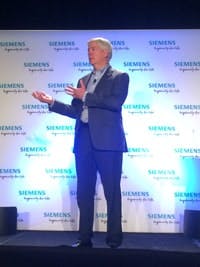For the 10th year, Siemens and Electro-Matic have partnered to bring the Manufacturing in America (MiA) Summit where new ideas become production innovations. This year’s event brought more than 2,000 people to General Motors’ Renaissance Center in Detroit.
This year’s theme centered on community, collaboration and innovation, and that message came through loud and clear from Paul Meloche, vice president of sales and marketing at Fori Automation, a technology-focused machine-tool designer and builder with its global headquarters in ShelbyTownship, Michigan.
“We’re one of the few remaining machine-tool builders here in the United States,” said Meloche, one of the speakers at the MiA Summit. In 2007, three-quarters of Fori’s revenue was from North America, and, as the financial crisis hit, it dropped from $72 million down to $55 million. The company also had just opened new facilities in Mexico, India and China. This global expansion turned out to be part of the reason the company excelled.
ALSO READ: The future of manufacturing: Only the innovative need apply
“Our management’s focus on risk management, instead of growth, saw us through 2008 and 2009,” explained Meloche. “In 2009-2010, more than 60% of what we built shipped outside the United States.”
To move forward, Fori needed to innovate and collaborate with a partner that could help it to grow outside of its primary automotive markets. “Sales are 80% automotive,” said Meloche. “We needed to limit our R&D, and we needed to diversify outside automotive.”
Fori’s plan was to leverage its existing competencies and expand into the aerospace industry. “If you’re going to sell to aerospace, don’t mention you’re from the automotive world,” warned Meloche. “How do you take a rail-guided vehicle (RGV) and turn that technology into a completely autonomous vehicle? We developed some new technologies. We leveraged our RGV body chassis to diversify into aerospace. We went from in-cabinet controls to finding nooks and crannies on the AGV to house them. In 2009, we felt we had a great new product, but we were struggling to get it accepted out there, so we partnered with Siemens, and our partnership grew.”
Fori came up with a whole new product line in the aerospace industry and sold three AGVs to an aerospace customer in Marietta, Georgia. “Then we moved into alternative energy, refurbishing a 40-year-old nuclear power plant in Canada,” said Meloche. Fori grew its automotive business, as well, providing AGVs to a Detroit powertrain facility for loading product in and out of assembly stations.
Another form of innovation comes in the form of digitalization. “Our intensity and focus on digitalization is stronger than ever before,” said Raj Batra, president, Digital Factory, at Siemens (www.siemens.com). “Either you’re driving digital disruption or you’re going to be disrupted. Half the world’s data was created in less than the past year. Thanks to the Industrial Internet of Things (IIoT), we’re truly at the dawn of a new era of manufacturing. Orders will form the basis of production. Machines will have the ability to organize themselves.”
Digitalization brings a set of challenges and opportunities, explained Batra. “We’re about to experience a generation change,” he said. “We saw the manufacturing part of the enterprise as a black box. It starts with developing your digital twin. When you have the physical virtually, you’re able to make great decisions.”
It’s a great time to be in manufacturing, announced Batra. “Companies have the opportunity to reinvent themselves,” he explained. “There’s great potential growth in high-tech manufacturing jobs. Robots and the advanced tools aren’t going to run themselves.”
Meloche agreed there’s a lot of opportunity available because of manufacturing automation, but employees need the advanced skill sets to fill those positions. “There’s more we can do to develop our future workforce,” said Fori’s Meloche. “We’re all tired of stealing controls engineers from each other. We have to do more to educate our youth on the skills required for our future workforce.”
“How do you create success and let free enterprise work?” asked Michigan’s Republican governor, Rick Snyder, who served as executive vice president, chairman of the board and interim CEO of Gateway computer hardware company before entering the political arena. “The first few years we did the fundamentals. If you want long-term success, it’s about having the most talented people, who will go on for generations. Our top priority today is talent.”
And the first step is convincing the next generation to give manufacturing a second look. “We’re going to educate children that manufacturing is a noble career,” said Alastair Orchard, vice president, Digital Enterprise, Siemens. “We’ve got to actively transform our companies.”
Michigan’s Republican governor, Rick Snyder, knows a thing or two about transformations and high-tech jobs, having served as executive vice president, chairman of the board and interim CEO of Gateway computer hardware company before entering the political arena. He brought of bit of that experience to his role as political leader of Michigan.
“How do you create success and let free enterprise work?” asked Snyder. “The first few years we did the fundamentals. If you want long-term success, it’s about having the most talented people, who will go on for generations. Our top priority today is talent.” Education, the economy and jobs need to be brought together to create a convergence and erase silos. “How do we help people to become career-connected?” Snyder asked. “It’s a relevant role to say, ‘Here are the jobs that are available, and here are the skills you need for those jobs.' There are not many unskilled jobs left in manufacturing. We had over 11% unemployment in Michigan, but now we have around 5% unemployment. Manufacturing is about making something better that improves people’s lives.”
Mike Bacidore is the editor in chief for Control Design magazine. He is an award-winning columnist, earning a Gold Regional Award and a Silver National Award from the American Society of Business Publication Editors. Email him at [email protected].
About the Author
Mike Bacidore
Editor in Chief
Mike Bacidore is chief editor of Control Design and has been an integral part of the Endeavor Business Media editorial team since 2007. Previously, he was editorial director at Hughes Communications and a portfolio manager of the human resources and labor law areas at Wolters Kluwer. Bacidore holds a BA from the University of Illinois and an MBA from Lake Forest Graduate School of Management. He is an award-winning columnist, earning multiple regional and national awards from the American Society of Business Publication Editors. He may be reached at [email protected]

Leaders relevant to this article:



